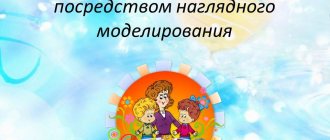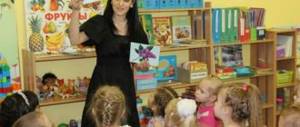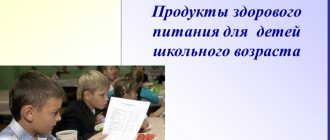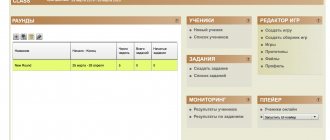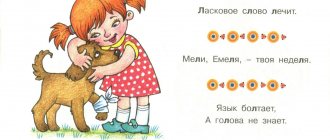Teaching retelling to preschool children
Methodology for teaching retelling to children in kindergarten
The material has been revised, taken from the book by Alekseeva M.M., Yashin B.I.
Methods of speech development and teaching the native language of preschoolers: Textbook. aid for students higher and Wednesday, ped. textbook establishments. It will be useful for young educators and pre-school methodologists. Works for retelling
Not every literary material can be the content for retelling.
You should choose only those works that children are able to retell themselves. When choosing works for retelling, the following requirements are taken into account: 1. they must have educational value and enrich the moral experience of children; be accessible in content - the work should contain familiar heroes, characters with clearly defined character traits, understandable motives for their actions; 2. have a clear composition with a well-defined sequence of actions (complex descriptive texts are not taken). The dynamism of the plot is of particular importance. Children can easily reproduce even relatively long works with a dynamic plot; must be written in exemplary language, without complex grammatical forms, contain varied and precise definitions, comparisons, preferably direct speech. Complex and long sentences with participial and adverbial phrases are difficult for children; available in volume. In the methodological literature, the requirements for the size of texts are contradictory. Some researchers believe that it is not the size that is important, but the content of the work. Others offer only short works. They are retold by children more confidently and consistently. There are different types of retelling: detailed or close to the text; short or condensed; selective; with text restructuring; with creative additions. In kindergarten, retelling close to the text is used mainly. It is easier than others and is a means of consolidating the content of what is read in memory, assimilating the logic and structure of the sample, its language. For example, a retelling with restructuring of the text from the perspective of different characters, due to its complexity, is carried out only in a preparatory group for school. When retelling with creative additions, older children come up with individual episodes, the beginning, and the ending of the work. The requirements for children's retellings are as follows: • Meaningfulness, i.e. Full understanding of the text is the main thing in learning. • Completeness of the transfer of the work, i.e. absence of significant omissions that violate the logic of presentation. • Consistency and coherence of the retelling. • Using the dictionary and phrases of the author's text and successfully replacing some words with synonyms. • Smooth retelling, absence of long, unnecessary pauses. Expressiveness and phonetic correctness of speech, culture of behavior during retelling. The methodology for teaching retelling in different age groups has both general and specific features. In younger groups, children are taught to listen and correctly perceive the work, and answer questions. Children of the third year of life talk together with an adult, in response to his questions, usually posed to the last word of the phrase, by inserting individual words (“What did the grandfather plant?” - “A turnip.” - “What kind of turnip grew?”). First, the teacher himself answers these questions, encouraging the child to join in the joint answer. Gradually, it becomes possible to use prompt questions, which children answer themselves with a whole sentence (“Once upon a time. Who lived and were? Grandfather and woman?” - “Once upon a time there was a grandfather and woman”). Children of the fourth year retell well-known fairy tales and stories based on repetition (“Kolobok”, “Turnip”), also with the help of the teacher. The teacher teaches children to perceive a fairy tale or story, follow the development of the action, answer questions about the text and thus gradually lead to its reproduction. Memorization of literary works is helped by their dramatization with the help of toys, tabletop, shadow, puppet theaters, moving pictures (on a magnetic basis, on a flannelgraph). As in the previous group, at first, joint storytelling between the teacher and the child predominates. When the teacher tells the story again, children can pronounce individual words and sentences. Along with prompt questions, direct questions are also used that require an answer in a whole phrase (“What did the hare say to Kolobok? Who met Kolobok next?”). Gradually, children begin to retell individual fragments of the text, and then the entire text, relying on the help of an adult. The most appropriate form of organizing children when retelling is an activity with the whole group. Let us first consider the methodological provisions that relate to the structure and methodology of conducting classes in middle and senior preschool age. The success of training depends primarily on the preparatory work carried out before the lesson. The preparation of the teacher consists of: a) choosing a work taking into account the speech skills of children, educational tasks, and timing; b) in analyzing the work and working on the expressiveness of the performance; c) in the selection in the text of words that are incomprehensible to children and methods of explaining them. Preparing children for retellings involves: a) enriching children's experience through observations, looking at pictures, conversations (in accordance with the content of the text); b) explanation of unfamiliar words before reading the work; c) drawing, modeling after initial familiarization with the text - this helps to clarify the characteristics of the characters and circumstances. Typical structure of retelling lessons: 1. Introductory part. Its goal is to create interest in the lesson, prepare children to perceive the text, which can be achieved through a short introductory conversation, showing a picture, reminding of observations, riddles. 2. Primary reading of the work. Children are invited to listen to the work and are told its title and author. A text that is new to children is told (read) without warning about a subsequent retelling, since the mindset of retelling limits the child’s attention, focuses him on memorization and thereby interferes with the holistic perception of the work of art. 3. Conversation on the content of what was read, aimed at analyzing and memorizing the text. 4. Repeated reading with the intention of subsequent retelling. 5. Children's retellings. 6. The final part of the lesson. Here you can use the dramatization of the work with the help of toys, table and shadow theater, and children's dramatization games. The structure of lessons discussed above is typical for retelling simple, short and familiar works. Long and complex works (in older groups) are read in advance, at least a week before the retelling (it has been established that retellings delayed in time are more complete, consistent and coherent). Therefore, at the next lesson, the children are immediately informed about the retelling, the work they already know is read, a conversation is held on its content, if necessary, they are read again, followed by the children’s retellings. All groups use different methodological techniques for teaching retelling. Conventionally, they can be divided into techniques that ensure: a) meaningful perception of the work; b) pedagogical guidance of the retelling process itself; c) analysis and assessment of children’s speech activity. In the middle group, children are taught to retell short fairy tales and stories read for the first time in class, expressively convey the dialogue of characters, listen and notice inconsistencies with the text in other children's retellings. For retelling, you can use Russian folk tales “The Ryaba Hen”, “The Wolf and the Seven Little Goats”, “Turnip”, the stories of K. D. Ushinsky “Geese”, “Ducks”, L. N. Tolstoy “The Grandfather Sat Down to Drink Tea”, fairy tale V. Suteeva “Chicken and Duckling” and others. It is difficult for a child to independently follow the logical sequence of the plot, remember and convey linguistic means. Therefore, in a conversation based on the content, with the help of questions, explanations, and illustrations, the main parts of the story are highlighted and questions are asked aimed at understanding the events and actions of the characters. The conversation includes exercises that develop the skills of expressive retelling (using different intonations in dialogues, conveying the experiences of the characters). Children's attention is also drawn to the language, to the characteristics of the characters, to the means of expression (the geese have long necks stretched out, red paws spread out; a long twig). In the process of retelling, the teacher widely uses the technique of reflected speech. If the child is silent, the teacher begins the story. The child repeats the phrase after him. Children at this age retell the text with significant omissions. Therefore, the teacher uses prompting of the necessary words and phrases, questions to the retelling and to the whole group, and correction of lexical and grammatical errors. Each retelling of children is evaluated : effort is encouraged, positive aspects and shortcomings are noted, and specific advice is given that other children can use. In the older group, children retell Russian folk tales “Teremok”, “The Fox and the Crayfish”; stories by K. D. Ushinsky “Know How to Wait”, L. N. Tolstoy “Fire Dogs”, “Kitten”, V. Oseeva “Blue Leaves”, N. Kalinina “About the Snow Bun”, etc. As in the middle group, conversation is a mandatory technique that prepares children for retelling. Its main purpose is to help children comprehend the content of the work, to penetrate into those internal connections that they cannot yet reveal on their own. Without such a conversation, children sometimes do not understand the idea of the work. In the conversation, in addition to questions aimed at understanding the text and remembering the sequence of events, various techniques are used to attract children’s attention to the language of the work, to the author’s description of the characters, to the description of the place and time of the action, to precise definitions, comparisons, and phraseological turns. A large place in the conversation is occupied by preparing children for an expressive retelling: the general tone of the retelling, intonation expressiveness in the transmission of individual fragments, and character dialogues are determined. Children can learn to speak individual meaningful phrases for different characters. The conversation should be lively and relaxed, and choral responses are allowed. In the older group, the retelling plan is widely used . This can be a ready-made plan proposed by the teacher, or a plan drawn up by him together with the children. The basis for drawing up a plan is the ability to make a semantic grouping of text, which should be taught specifically. First, children are asked questions that show individual semantic segments of the work, and then the plan is formulated in the form of instructions: 1. First, tell us why it can be difficult to save children in fires. 2. Then talk about how fire dogs are trained to rescue children. 3. Don’t forget to tell us about Bob: how he saved the girl and why he first took the doll out of the fire (in the retelling he told N. Tolstoy’s “Fire Dogs”). A spatial model that captures the most significant parts of the text can act as a retelling plan. After learning the ability to use and build models of a read text, children identify the main semantic episodes, establish connections between them and give a detailed and compositionally organized retelling. In order for children to memorize the text, the teacher can read individual passages selected in accordance with the drawn up plan or at the request of the children, draw their attention to individual words and expressions. Techniques for guiding children's retellings become more complex. This part of the lesson uses directions (“Think about how you will tell everything”). If the works are large in volume, then the children retell them in parts: the teacher in advance (in preparation for the lesson) identifies complete semantic parts of the text and suggests that the children tell them in turn. Children, together with the teacher, and then independently agree on which place to stop. The lesson ends with one child retelling the text. Works that contain dialogue are retold by role and dramatized. In cases of difficulty for children, as in the previous group, auxiliary questions are used (mainly after the retelling, so as not to disrupt its integrity and smoothness), prompting of the necessary words or phrases, and correction of errors. Children are involved in evaluating retellings . By listening to the teacher’s analysis of retellings, children learn to tactfully and kindly note the merits and mistakes in each other’s retellings. In the preparatory group for school, the literary material for retelling becomes much more complicated. Along with narrative texts, children learn to reproduce simple descriptions. They retell Russian folk tales “The Boasting Hare”, “The Fox and the Goat”, the stories of K. D. Ushinsky “Four Wishes”, L. N. Tolstoy “The Bone”, V. Bianchi “Bathing Bear Cubs”, V. Oseeva “Simply old lady." Requirements for retellings are increasing. During analysis, children more accurately correlate retellings with the text, detect omissions, and learn to approach the evaluation of retellings taking into account certain criteria: independence, consistency, completeness, smoothness, expressiveness. The special attention of the teacher in this group requires learning to retell poetic descriptions of nature. Preparing children for retelling is closely connected with observations, with the activation of their ideas about nature and familiar literary images. This group uses selective retelling (linguistically interesting fragments outlined by the teacher and chosen by the children), retelling from the perspective of different characters, inventing continuations to the texts read, composing stories and fairy tales by analogy with the ones read
We recommend watching:
Storytelling in Kindergarten Essay by Kindergarten Teacher. My educational philosophy. Multimedia technologies in the pedagogical process in preschool educational institutions Methodological work in kindergarten
Similar articles:
Dance festival in kindergarten for children 5-7 years old. Scenario
Outdoor games as a means of harmonious development of a child
From work experience. Nurturing a culture of verbal communication in preschoolers
How to write a character reference for a child in kindergarten
Features of the intellectual development of preschool children
Methodology for teaching retelling to preschoolers
Preschool childhood is a period when special attention is paid to the development of coherent speech in children. A properly organized retelling will provide invaluable assistance in working on speech skills. Learning to retell helps enrich vocabulary, develop perception, memory, attention, and thinking. At the same time, pronunciation is improved, norms for constructing sentences and the entire text are learned. The use of highly artistic texts of children's literature makes it possible to effectively work on the development of a “sense of language” - attention to the lexical, grammatical and syntactic aspects of speech, the ability to evaluate the correctness of statements in terms of compliance with their language norm. In addition, it develops positive personality traits in the child: kindness, responsiveness, tolerance, etc.Retelling literary works in kindergarten is a means of developing speech based on a model; a type of work for children, the essence of which is a coherent presentation of the text they have listened to. This is an easier type of monologue speech compared to storytelling, since it adheres to the author’s composition of the work, it uses the author’s ready-made plot and ready-made speech forms and techniques.
Retelling should be taught to children only after 5 years of age, since at this time the foundations of monologue speech are laid in children. Before this age, it is necessary to carry out preparatory exercises.
Already in the second junior group, the teacher teaches children to follow the development of action in a fairy tale or story; name and sympathize with the heroes of the work. The speech activity of children associated with retelling appears initially in the form of answers to questions; you can also involve children in a joint retelling with the teacher, encouraging them to pronounce individual words or sentences (when the teacher re-tells the fairy tale). This work is carried out in classes on familiarization with fiction.
Starting from the middle group, specially organized retelling classes are held. Retelling is a new type of speech activity. Therefore, it is important to arouse children’s keen interest in retelling and support manifestations of activity and independence. It is necessary to take into account the characteristics of children's perception of literary and artistic works, as well as the characteristics of the processes of thinking, speech, and the level of development of attention. At the very first lessons, children are asked to retell fairy tales that are well known to them in the past, and in subsequent lessons they are asked to retell new texts that they have just listened to. In order to perceive a literary work and reproduce it in a retelling, children 4-5 years old need the help of a teacher. It is difficult for them to understand the essence of the events described, to trace the logical connection between parts of a story or fairy tale. Therefore, in children's presentation, omissions, distortions, and rearrangements of material may occur, and then the retelling will not correspond to the content and structure of the original. The child does not yet know how to independently isolate figurative descriptions and comparisons and omits them.
Children aged 5-6 years when retelling literary works are able to show greater independence and activity than younger preschoolers. At this age, the process of perception and emotional development of works of art is improved. Older preschoolers orient themselves more freely in literary material, their vocabulary expands, their linguistic sense, attention and interest in figurative words increases. The role of voluntary actions also increases - children make efforts to better remember and more accurately reproduce what they read. Children can already use their own, successfully found figurative expressions that are lexically and syntactically close to the language of the work of art. Fairy tales and stories recommended for retelling in the senior group are somewhat more complex in their structure, language material and the number of characters than the texts for the middle group.
In the preparatory group for school, retelling classes consolidate and improve the speech skills acquired by children in the senior group. Preschoolers continue to learn to express thoughts coherently, consistently, completely, without distortion, omissions, or repetitions. Children are improving their ability to convey the dialogues of the characters emotionally, with different intonations, to use semantic stresses, pauses, and certain artistic means characteristic of fairy tales (inception, repetitions, etc.) in retellings. Children learn to speak slowly, loudly enough, without tension. Children's independence increases.
Retelling is not an end in itself, but a means of speech development for preschool children. Therefore, there are certain requirements for a literary text for retelling, the essence of which is as follows:
- accessible, understandable content for children;
- variety of genres;
- clear composition;
- simple and literate language using a variety of linguistic means;
- small volume.
In addition, each work should teach something useful and develop positive personality traits in the child (kindness, responsiveness, tolerance).
It is advisable to use several genres for retelling: story and description, folk and author's tales. You can choose different fairy tales: short (“The Fox and the Jug”) and long (“Geese and Swans”) - each has its own characteristics and its own possibilities for educational impact.
The poem is not suitable for retelling - the unity of form and content should not be violated, or inattention to poetic form should be cultivated. This is evidenced by numerous studies. Experience shows that children strive to recite a poetic text by heart.
Preschoolers retell a literary work well if the story captivates them, causes strong emotions, and becomes close to them, even if the content does not relate to their direct experience. Therefore, for retelling, it is better to select texts related to situations familiar to children, or those that can activate their imagination and influence their feelings. At the same time, the work of imagination should be based on the ideas and simple concepts that preschoolers have.
It is easier for children to comprehend a story if it is structured in such a way that a logical connection can be traced between its parts, one part leads to and explains the other, and unnecessary details do not interfere with understanding the main thing in the work.
The language of the works that we read and offer for retelling to children should be a model for them. The works of L.N. are very good in this sense. Tolstoy, K.D. Ushinsky. Stories by L.N. Tolstoy is especially suitable for retelling also because their language gradually becomes more complex: the text of stories for little ones is much simpler, the sentences are shorter than in such works as “The Bone”, “The Lion and the Dog”, etc. You can also use the works of V. Oseeva , V. Bianchi, M. Prishvina.
If there are new words in the text proposed for retelling, then first the children try to replace them with familiar, familiar ones. Subsequently, as observations have shown, they tend to use the new word when retelling and are even proud of it.
It is very important to pay attention to the grammatical structure of the work chosen for retelling. Complex and long sentences, participial and adverbial phrases, introductory sentences, and complex metaphors are not yet available to preschool children. Thus, stories in prose that are accessible to preschoolers in content, language and grammatical structure are suitable for retelling.
This type of speech such as description is very difficult for children. Often older preschoolers begin the retelling with the beginning, omitting various kinds of descriptions. This is explained by the fact that children remember more vividly what hurt their feelings more strongly. This does not at all contradict the fact that children, if there is a vivid image in their ideas, sometimes supplement their retelling with a description that may not exist, for example, in a fairy tale. During the observation process, it turned out that if children have an idea about the object or phenomenon described in the story, then they describe it without difficulty and with interest. If children's attention is focused on the plot, then they miss the descriptive passages. Consequently, for retelling it is necessary to offer works in which the descriptions do not coincide with the moment of particularly strong plot tension.
In the theoretical and methodological literature, the requirements for the size of texts for retelling are contradictory. Some researchers of children's speech believe that it is not the size that is important, but the content and structure of the story. Others suggest giving children only short works to retell. When selecting literary texts for retelling, one should, first of all, take into account their content, accessibility, dynamism and emotionality. At the same time, it is also important to remember that the size of the work affects the perception, digestibility and quality of the retelling. Regarding this parameter of the work selected for retelling, the following must be taken into account:
- if the retelling was already carried out in the middle group, then in the older group in the second half of the year, after a second reading by the teacher of the work, the children can correctly, consistently and sufficiently fully reproduce a long story or fairy tale without additional questions from the teacher;
- At the beginning of work, the quality of children's retellings depends on the size of the work. As practice shows, children retell shorter works of equal complexity and dynamism more consistently, more accurately and more fully than longer ones.
Thus, work on teaching retelling should be carried out systematically (about 1–2 times a month as part of a lesson). You should start with short fairy tales and stories, as the child retells them more confidently.
Children should not be required to retell the work immediately after reading it. Preschoolers need to be prepared for this type of activity.
The structure of a lesson is determined by the variety of its tasks.
A retelling lesson has the following typical structure:
1. Introductory part. Preparing children to perceive a new work, mainly its ideas (reviving similar personal experiences of children, showing pictures, etc.).
Tasks:
- find out children’s knowledge on the topic of the work;
- ensure understanding of words and expressions that will be in the text;
- expand children’s understanding of the subject discussed in the work;
- ensure the emotional mood of children before listening to the work.
2. Primary reading without warning about subsequent retelling to ensure free artistic perception. These two stages are omitted if the work is already well known to the children.
3. Preparatory conversation (analysis of the work).
Its goals:
- clarification of the content (mainly the ideas and characteristics of the images, the sequence of events),
- drawing attention to the language (unobtrusively emphasize precise definitions, comparisons, phraseological units),
- active preparation for expressive retelling (work on the direct speech of the characters, understanding intonation, stress, tempo, especially in important compositional moments).
All these goals are solved in unity, with a consistent analysis of the text along the course of its plot.
4. Repeated reading, summarizing the results of the analysis. In this case, a retelling attitude is appropriate, for example: “Listen to how I read.” The secondary reading should be slower than the first.
5. Pause to prepare children for answers, to memorize the text (a few seconds).
6. Retelling (3-7 people). Active teacher leadership. At the end, call the child with the most vivid speech or use emotional techniques (role-playing, dramatization).
7. Analysis of children's retellings (the first retelling is analyzed in detail, the rest - in less detail; in the preparatory group the children themselves are involved in the analysis).
It must be remembered that the assessment of creative artistic activity, such as retelling, must be especially tactful, allowing for variability in execution. Children should be given appropriate wording for their value judgments: “It seems to me...”, “I advise Seryozha...”, “Or maybe it’s better...”
Let us dwell in more detail on the methods of teaching children to retell.
Techniques that contribute to the effectiveness of the perception of a work of art:
- examination of paintings, illustrations, objects that will be discussed in the story;
- lexical and grammatical exercises on the lexical and grammatical material of the story;
- the use of riddles, proverbs, nursery rhymes, poems, etc., to promote understanding of the content of the story;
- observations in nature and surrounding life, appeal to the personal experience of children.
Techniques for working on the text of a work:
- conversation on the work (reveals what the work is about, the main characters, the actions of the characters and their assessment, questions to analyze the language of the work);
- arranging in a logical sequence a series of plot pictures for a story or fairy tale;
- extracting phrases from the text for each picture;
- coming up with additional and missing pictures for individual text fragments;
- partial retelling during a conversation (particularly difficult parts of the text are retold, where there is a description, dialogues of the characters);
- drawing up a plan for the work (series of plot pictures or subject pictures selected for each part of the text, as well as symbols and pictograms can be used as auxiliary tools).
Techniques that help improve children's retellings:
- To achieve coherence and smoothness of retellings, it is most appropriate for the teacher to suggest a word or phrase. At the initial stages of education, a joint retelling of the teacher and the child is practiced (the child finishes the phrase he has begun, alternately pronouncing successive sentences), as well as reflected retelling (the child repeats what the teacher said, especially the initial phrases). By the way, even in a confident retelling, a hint is useful for immediately correcting a child’s grammatical or semantic error.
- In cases where the work is divided into logical parts and is quite long (fairy tales “Teremok”, “On the Car” by N. Pavlova, etc.), a retelling in parts is used, and the teacher guides the change of storytellers, stopping the child at the end of the part and sometimes emphasizing this is a circumstance.
- If there is dialogue in the work, then retelling by roles (in persons) comes to the aid of the teacher, especially in developing the expressiveness of children's speech.
- In older groups, it is possible to use methods of conveying the text from the first person or from the faces of its different characters, as well as constructing a retelling by analogy with what was read, with the inclusion of another character. I would like to emphasize the need for a particularly tactful, reasonable implementation of these techniques, and careful treatment of the author’s text, especially the classic, not adapted one. Educational syntactic exercises for children in the modification of direct and indirect speech are more appropriate in didactic and training texts.
- gaming techniques (eg: retelling while sitting in front of a model TV).
Bibliography:
1. Borodich A. M. Methods of developing children’s speech, M., 1981.
2. Glukhov V.P. Formation of coherent speech in preschool children with general speech underdevelopment. — 2nd ed., rev. and additional - M.: ARKTI, 2004. - 168 p.
3. Konovalenko V.V., Konovalenko S.V. Formation of coherent speech and development of logical thinking in children of senior preschool age with ODD. Some methods and techniques. – M.: “GNOM and D”, 2003 – 48 p.
4. Korotkova E.P. Teaching preschool children storytelling. – M., “Enlightenment”, 1982 – 128 p.
